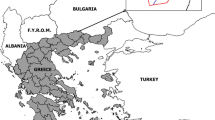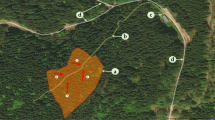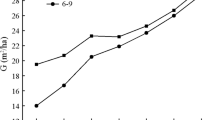Abstract
A comparative study was conducted in the second commercial thinning of a 12-year-old slash pine (Pinus elliottii Engelm.) plantation in South Africa. The goal of the study was to compare semi-mechanized tree-length harvesting with fully mechanized cut-to-length (CTL harvesting) in terms of: compliance with silvicultural prescriptions, value and volume recovery, productivity, cost and residual stand damage. The two systems were tested on 32 adjacent plots with a mean surface of 4000 m2 each. Plots were randomly allocated to the two treatments, so that each treatment was replicated 16 times. The experiment consisted of a classic time study, followed by the visual inspection of all plots for determining damage frequency and severity. While mechanization allowed a dramatic (tenfold) increase in worker productivity, it also resulted in a proportional increase in team cost, which offset the large efficiency benefit and ended up with both methods incurring similar production cost (180–200 ZAR m3). However, mechanized CTL harvesting resulted in a significant reduction in residual stand damage frequency (from 5.2 to 2.9%) and severity (28% smaller wounds). Mechanized CTL is preferable, because it can reduce the frequency and severity of residual stand damage. In social terms, however, mechanization reduces employment potential but promotes job quality, while conventional harvesting solutions can employ many more people, but offer low-paid, tiresome and potentially hazardous jobs.







Similar content being viewed by others
References
Ackerman SA, Seifert S, Ackerman PA et al (2016) Mechanized pine thinning harvesting simulation: productivity and cost improvements as a result of changes in planting geometry. Croat J For Eng 37:1–12
Acuna M, Kellogg L (2009) Evaluation of alternative cut-to-length harvesting technology for native forest thinning in Australia. Int J For Eng 20:17–25
Aho P, Fiddler G, Filip G (1989) Decay losses associated with wounds in commercially thinned true fir stands in northern California. USDA Forest Service Research Paper PNW-403. 8 p
Asikainen A, Anttila P, Verkerk H, Diaz O, Röser D (2011) Development of forest machinery and labour in the EU in 2010-2030. In: Proceedings of the 44th international FORMEC conference, October 9–13, Graz, Austria. 8 p. https://www.formec.org/proceedings/25-austria-2011-proceedings.html. Accessed 29 Apr 2018
Bell J (2002) Changes in logging injury rates associated with use of feller-bunchers in West Virginia. J Saf Res 33:463–471
Björheden R, Apel K, Shiba M, Thompson M (1995) IUFRO forest work study nomenclature. Swedish University of Agricultural Science, Department of Operational Efficiency, Garpenberg. 16 p
Bobik M (2008) Damage to residual stand in commercial thinnings. Southern swedish Forest Research Centre, SLU Master Thesis no 127, Alnarp, Sweden. 32 p
Boston K, Murphy G (2003) Value recovery from two mechanized operations in the southeastern United States. South J Appl For 27:259–263
Bradford JB, Palik BJ (2009) A comparison of thinning methods in red pine: consequences for stand level growth and tree diameter. Can J For Res 39:489–496
Bredenkamp B (2000) Volume and mass of logs and standing trees. In: Owen DL (ed) South African forestry handbook 2000, vol 1, 4th edn. South African Institute of Forestry, Pretoria, pp 167–174
Bulman D, Eden M, Nguyen H (2017) Transitioning from low-income growth to high-income growth: is there a middel-income trap? J Asia Pac Econ 22:5–28
Camp A (2002) Damage to residual trees by four mechanized harvest systems operating in small-diameter, mixed-conifer forests on steep Slopes in Northeastern Washington: a case study. West J Appl For 17:14–22
Carey P, Murphy G (2005) Mechanized versus manual log-making in two Chilean Pinus radiata stands. N Z J For Sci 35:25–34
Cossens P (1991) Operator log makingg ability on mechanized processor. Logging Industry Research association, Rotorua, New Zealand, LIRA Technical Report 16 (14)
Erasmus D (1994) National terrain classification for forestry. Institute for Commercial Forestry Research (ICFR). ICFR, Scottsville, bulletin series, 11, 94
Eriksson M, Lindroos O (2014) Productivity of harvesters and forwarders in CTL operations in northern Sweden based on large follow-up datasets. Int J For Eng 25:179–200
Evans J (1992) Plantation forestry in the tropics: tree planting for industrial, social, environmental, and agroforestry purposes. Oxford University Press, Oxford
Fields G (2010) Labor market analysis for developing countries. Cornell University, ILR School Working Paper 157, Cornell, NY, USA. http://digitalcommons.ilr.cornell.edu/workingpapers/157. 17 p. Accessed 29 Apr 2018
Froese K, Han H (2006) Residual stand damage from cut-to-length thinning of a mixed conifer stand in Northern Idaho. West J Appl For 21:142–148
Gullberg T (1995) Evaluating operator-machine interactions in comparative time studies. Int J For Eng 7:51–61
Han HS, Kellogg LD (2000) Damage characteristics in young douglas-fir stands from commercial thinning with four timber harvesting systems. West J Appl For 15(1):27–33
Han HS, Kellogg LD, Filip G et al (2000) Scar closure and future timber value losses from thinning damage in western Oregon. For Prod J 50:36
Heitzman E, Grell AG (2002) Residual tree damage along forwarder trails from cut-to-length thinning in Maine spruce stands. North J Appl For 19:161–167
Holtzscher MA, Lanford BL (1997) Tree diameter effects of cost and productivity of cut-to-length systems. For Prod J 47:25
Hunt J, Krueger KW (1962) Decay associated with thinning wounds in young-growth western hemlock and douglas-fir. J For 60:336–340
Jackson SM, Fredericksen TS, Malcom JR (2002) Area disturbed and residual stand damage following logging in a Bolivian tropical forest. For Eco Manag 166:271–283
Kellogg L, Bettinger P (1994) Thinning productivity and cost for a mechanized cut-to-length system in the northwest pacific coast region of the USA. J For Eng 5:43–54
Kerr G, Haufe J (2011) Thinning practice: a silvicultural guide. Forestry Commission, Edinburgh
Koŝir B (2008) Modelling stand damage and comparison of two harvesting methods. Croat J For Eng 29:5–14
Laitila J (2008) Harvesting technology and the cost of fuel chips from early thinnings. Silva Fenn 42:267–283
Lall S, Harris S, Zmarak S (2006) Rural-urban migration in developing countries: a survey of theoretical prediction and empirical finding. World Bank Policy Research Working Paper 3915:1–44
Lanford B, Stokes B (1995) Comparison of two thinning systems. Part 1. Stand and site impacts. For Prod J 45:74–79
Lindroos O, La Hera P, Häggström C (2017) Drivers of advances in mechanized timber harvesting—a selective review of technological innovation. Croat J For Eng 38:243–258
Magagnotti N, Kanzian C, Schulmeyer F, Spinelli R (2011) A new guide for work studies in forestry. Int J For Eng 24:249–253
Magagnotti N, Spinelli R, Güldner O, Erler J (2012) Site impact after motor-manual and mechanized thinning in Mediterranean pine plantations. Biosys Eng 113:140–147
Marshall H, Murphy G, Boston K (2006) Evaluation of the economic impacts of length and diameter measurement error on mechanical harvesters and processors operating in pine stands. Can J For Res 36:1661–1673
McEwan A, Magagnotti N, Spinelli R (2016) The effects of number of stems per stool on cutting productivity in coppiced Eucalyptus plantations. Silva Fenn 50(2):1448
Mcneel J, Ballard T (1992) Analysis of site stand impacts from thinning with a harvester-forwarder system. J For Eng 4:23–29
Meng W (1978) Baumverletzungen durch transportvorgaenge bei der holzernte: ausmass und verteilung, folgeschaeden am holz und versuch ihrer bewertung. Schriftenreihe der landesforstverwaltung baden-wuerttemberg (Germany)
Murphy G (2003) Mechanization and value recovery: worldwide experiences. In: Proceedings of the wood for Africa forest engineering conference, July 2002, Pietermaritzburg, South Africa. pp 23–32. OSU, Forest Engineering Department, Corvallis, Oregon
Nichols M, Lemin R Jr, Ostrofsky w (1994) The impact of two harvesting systems on residual stems in a partially cut stand of northern hardwoods. Can J For Res 24:350–357
Ostrofsky W, Seymour R, Lemin R Jr. (1986) Damage to northern hardwoods from thinning using whole-tree harvesting technology. Can J For Res 16:1238–1244
Parker R, Park R, Clement B, Gibbons W (1995) Effect of number of log grades on log making errors. LIRO Report 20. 7 p. Rotorua, New Zealand
Picchio R, Neri F, Maesano M et al (2011) Growth effects of thinning damage in a corsican pine (Pinus laricio poiret) stand in central italy. For Ecol Manag 262:237–243
Purfürst T, Lindroos O (2011) The correlation between long-term productivity and short-term performance ratings of harvester operators. Croat J For Eng 32:509–519
Ramantswana M, McEwan A, Pauw J (2012) Determining the effect of tree size, bark-wood bond strength and tree form on the productivity of an excavator-based harvester in Acacia mearnsii in the KwaZulu-Natal forestry region of South Africa. South For: J For Sci 74(3):151–157
SAS Institute Inc (1999) StatView Reference. SAS Publishing, Cary, NC. ISBN-1-58025-162-5. pp. 84-93
Scott A (1973) Work measurement: observed time to standard time. For Comm Bull 47:26–39
Spinelli R, Magagnotti N (2011a) The effects of introducing modern technology on the financial, labour and energy performance of forest operations in the Italian Alps. For Policy Econ 13(7):520–524
Spinelli R, Magagnotti N (2011b) The effects of introducing modern technology on the financial, labour and energy performance of a mobile chipper. Silva Fenn 45(1):85–95
Spinelli R, Visser R (2008) Analyzing and estimating delays in harvester operations. Int J For Eng 19:35–40
Spinelli R, Visser RJM (2009) Analyzing and estimating delays in wood chipping operations. Biomass Bioenerg 33(3):429–433
Spinelli R, Ward SM, Owende PM (2009) A harvest and transport cost model for Eucalyptus spp. fast-growing short rotation plantations. Biomass Bioenerg 33(9):1265–1270
Spinelli R, Hartsough B, Magagnotti N (2010a) Productivity standards for harvesters and processors in Italy. For Prod J 60(3):226–235
Spinelli R, Magagnotti N, Nati C (2010b) Benchmarking the impact of traditional small-scale logging systems used in mediterranean forestry. For Ecol Manag 260:1997–2001
Spinelli R, Magagnotti N, Nati C (2011) Work quality and veneer value recovery of mechanized and manual log-making in Italian poplar plantations. Eur J For Res 130(5):737–744
Spinelli R, Lombardini C, Magagnotti N (2014) The effect of mechanization level and harvesting system on the thinning cost of Mediterranean softwood plantations. Silva Fenn 48(1):1003
Steyn L (2017) Reserve bank announces surprise interest rate cut. Mail and Guardian. https://mg.co.za/article/2017-07-20-reserve-bank-announces-interest-rate-cut
Tsioras P, Liamas D (2015) Residual tree damage along skidding trails in beech stands in Greece. J For Res 26:523–531
Visser R, Spinelli R (2012) Determining the shape of the productivity function for mechanized felling and felling-processing. J For Res 17:397–402
Waters I, Kembel S, Gingras JF, Shay J (2004) Short-term effects of cut-to-length versus full-tree harvesting on conifer regeneration in jack pine, mixedwood, and black spruce forests in Manitoba. Can J For Res 34:1938–1945
Whitney R (1991) Quality of eastern white pine 10 years after damage by logging. For Chron 67:23–26
Acknowledgements
The research was funded by the (FP&M) SETA and Nelson Mandela University. Special thanks go to SAFCOL for providing land, equipment and manpower.
Author information
Authors and Affiliations
Corresponding author
Additional information
Communicated by Eric R. Labelle.
Rights and permissions
About this article
Cite this article
Dembure, T.P., McEwan, A., Spinelli, R. et al. A comparison between two alternative harvesting systems in the thinning of fast-growing pine plantations under the conditions of low labour cost. Eur J Forest Res 138, 43–52 (2019). https://doi.org/10.1007/s10342-018-1152-x
Received:
Revised:
Accepted:
Published:
Issue Date:
DOI: https://doi.org/10.1007/s10342-018-1152-x




